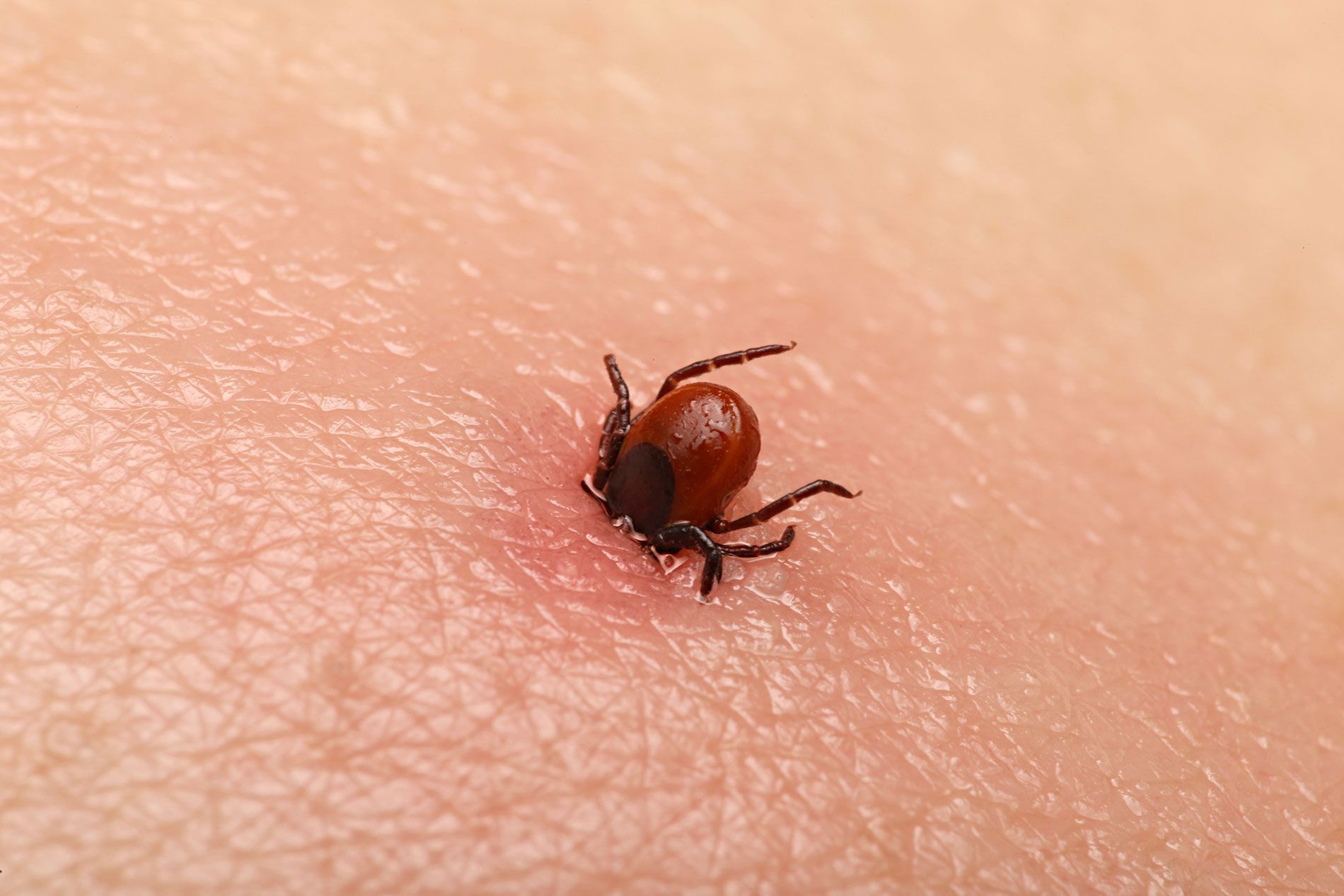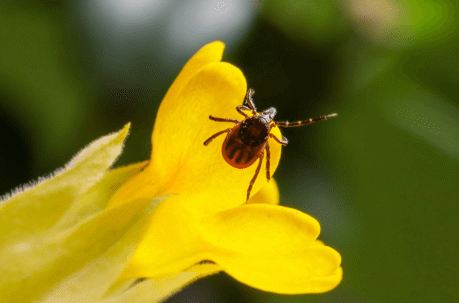12 SPOTS ON THE BODY WHERE YOU'RE MOST LIKELY TO FIND A TICK
Tick season is here, and it’s already shaping up to be a rough one. The United States is seeing the highest number of reported emergency room visits for tick bites since 2019, according to recent data from the Centers for Disease Control and Prevention (CDC).
Recent estimates suggest that more than 31 million people in the U.S. are bitten by ticks each year. Rates of tick-borne diseases, like Lyme disease and Rocky Mountain Spotted Fever, have more than doubled over the last two decades—a result of rising temperatures, shifting land use, and other factors.
But getting a tick bite doesn’t necessarily mean you will get sick. Most tick bites don’t lead to disease, and the majority of tick-borne diseases can be prevented by early removal of the tick, research shows.
“Frequent tick checks are important because they help prevent infections like Lyme disease, which can cause serious long-term health issues if not caught early,” Bobbi Pritt, MD, the director of the Clinical Parasitology Laboratory at Mayo Clinic and a spokesperson for the College of American Pathologists, told Health.
With that in mind, where on your body should you pay extra attention to when scanning for ticks? Here’s what to know about where ticks like to hang out—as well as what to do if you actually find one on your body.

Ticks tend to bite warm areas of the body, like in your armpit or behind your knees.
Fast Facts:
- Tick season is already off to a rough start, with bite-related ER visits hitting a five-year high.
- Finding and removing ticks early is key, as some diseases transmit within hours of attachment.
- Check for ticks in warm, hidden areas of your body, like your inner thighs, scalp, and waistline.
Why Do a Tick Check?
Ticks transmit diseases to humans by feeding on the blood of infected animals and contracting pathogenic bacteria, viruses, or parasites. Then, when they’re snacking on their next victim’s blood, they can inject the pathogen into the new host.
In the United States, at least 17 human diseases are caused by numerous species of ticks.6 The most common tick-borne disease—accounting for nearly 80% of tick-borne illnesses nationwide—is Lyme disease, a bacterial infection that can cause fatigue, headache, and a skin rash.
Lesser-known diseases from ticks include:
- Babesiosis, a parasitic disease that infects red blood cells
- Tularemia, a potentially serious bacterial illness that can be treated with antibiotics
- Anaplasmosis, a bacterial infection that causes flu-like symptoms
- Apha-gal syndrome, a rare red meat allergy, developed after being bitten by a tick
The percentage of ticks that are infected ranges from 0 to 50% and largely varies by location. For example, black-legged ticks, which are mostly found in the southeastern U.S., are rarely infected.
Some pathogens, such as the Powassan virus, can be transmitted in as little as 15 minutes, whereas a tick needs to be attached for several hours—in some cases, 24 or more—to transmit Lyme disease. “Finding and removing a tick quickly can stop infection before it starts,” Pritt said.
Where Are Ticks Usually Lurking?
Ticks don’t fly or jump. Instead, they cling onto vegetation with their back legs and reach their front legs out, waiting for a host to brush by, said Charlotte Mao, MD, a pediatric infectious disease physician and a member of the Scientific Advisory Board for Bay Area Lyme Foundation.
When that happens, they transfer onto the host—say, you or your dog—then “crawl and climb to different locations on the body to eventually attach and bite,” Mao told Health.
Ticks can hide out all over your body, like your chest, shoulders, ankles, wrists, and feet. But they “often prefer warm areas of the body where there are skin folds or where clothing presses up to skin,” Mao said.
According to one survey from 2020, of 722 deer ticks that were attached to people, most of them—about 16%—were found on the thigh, followed by around the waist, the stomach, and groin. The eight remaining spots were:
- Along the upper back
- On the scalp
- On the calves and shins
- Along the upper arms
- Behind the knees
- In the armpits
- Along the neck
- Around the lower back
In kids, ticks tend to bite around the head and neck. Why? Children are more likely to play and roll around in grass, said Mao, and their heads are closer to the height of vegetation.
The lone star tick, which resides in the eastern, southeastern, and south-central U.S. and can transmit germs such as ehrlichiosis and Heartland virus disease (but not Lyme disease), is aggressive and tends to bite quickly on the lower half of the body, like the leg, thigh, or groin area.
Dog ticks, which can transmit diseases like anaplasmosis and babesiosis and are usually found east of the Rocky Mountains, prefer to climb upward and bite the head or neck region, adds Mao.
How to Check For Ticks
The U.S. Department of Agriculture recommends bathing or showering within two hours of coming back indoors after hiking, walking, camping, gardening, and picnicking. Doing so will help you find or wash away lingering ticks, as it usually takes a couple of hours for a tick to dig around and find skin to bite, according to the National Institutes of Health (NIH).
To conduct a tick check, use a hand-held or full-length mirror to scan your entire body, including your underarms, belly button, ears, and hair. You can also ask a friend to help (especially with those hard-to-reach areas like your scalp or back). Some ticks, such as black-legged ticks, are minuscule and may look like a sesame seed, said Mao.
Tick bites are most easily identified when the tick is still attached to the skin while feeding, Chantal Vogels, PhD, an assistant professor of epidemiology (microbial diseases) at Yale School of Public Health, told Health. The goal is to catch and remove the tick before it’s filled up with your blood, the NIH states.
Like other bug bites, a tick bite typically causes a red lump. In general, tick bites aren’t painful, whereas bites and stings from other insects typically cause pain. Occasionally, however, a tick bite may lead to local swelling, itchiness, blistering, and bruising.
What to Do If You Find One
If you find a tick latched onto your skin, it’s crucial to take immediate action. Here’s what to do:
- Decide on your removal method: A pair of tweezers, a tick removal device, or your fingers.
- Grab onto the tick as close to your skin as possible.
- Slowly pull upward and away, removing the whole tick in one piece.
- If part of the tick, like the mouth, breaks off and remains lodged in your skin, remove those parts, too.
- Clean out the bite with soap and water or rubbing alcohol to avoid infection, Vogel said. (Do not use petroleum jelly, heat, or other chemicals to clean out the bite, which the CDC warns can agitate the tick and push infected fluid out of it and into your body.)
- Get rid of the tick by flushing it down the toilet, wrapping it in tape, placing it in a sealed container, or dousing it in alcohol. (Do not crush the tick between your fingers.)
- Check for additional ticks, Vogel stressed.
One thing the CDC says you shouldn’t do is get the tick tested for pathogens. That’s because a negative result may give you false reassurance, and a positive result could cause unnecessary worry, given that it doesn’t necessarily mean you will get sick.
It’s always a good idea to monitor yourself for symptoms—like a rash or fever—after a tick bite. With Lyme disease, a bullseye rash will appear about a week after the bite.
If you notice anything unusual, contact a doctor and clue them in on when the bite took place and where you were exposed to the tick, Vogel said. Early treatment with antibiotics or anti-parasitic drugs can improve your prognosis and prevent severe illness.
Centers for Disease Control and Prevention. About Rocky Mountain spotted fever.
Finally, the best way to prevent tick-borne diseases is to avoid tick bites in the first place. In addition to checking for ticks, wear permethrin-treated clothing and use insect repellents. “Prevention is better than treatment,” said Vogel.







